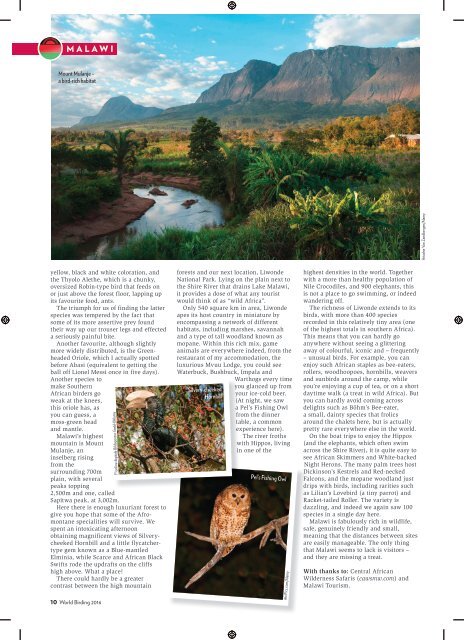BWT Travel Guide
You also want an ePaper? Increase the reach of your titles
YUMPU automatically turns print PDFs into web optimized ePapers that Google loves.
MALAWI<br />
Mount Mulanje –<br />
a bird-rich habitat<br />
Ariadne Van Zandbergen/Alamy<br />
yellow, black and white coloration, and<br />
the Thyolo Alethe, which is a chunky,<br />
oversized Robin-type bird that feeds on<br />
or just above the forest floor, lapping up<br />
its favourite food, ants.<br />
The triumph for us of finding the latter<br />
species was tempered by the fact that<br />
some of its more assertive prey found<br />
their way up our trouser legs and effected<br />
a seriously painful bite.<br />
Another favourite, although slightly<br />
more widely distributed, is the Greenheaded<br />
Oriole, which I actually spotted<br />
before Abasi (equivalent to getting the<br />
ball off Lionel Messi once in five days).<br />
Another species to<br />
make Southern<br />
African birders go<br />
weak at the knees,<br />
this oriole has, as<br />
you can guess, a<br />
moss-green head<br />
and mantle.<br />
Malawi’s highest<br />
mountain is Mount<br />
Mulanje, an<br />
inselberg rising<br />
from the<br />
surrounding 700m<br />
plain, with several<br />
peaks topping<br />
2,500m and one, called<br />
Sapitwa peak, at 3,002m.<br />
Here there is enough luxuriant forest to<br />
give you hope that some of the Afromontane<br />
specialities will survive. We<br />
spent an intoxicating afternoon<br />
obtaining magnificent views of Silverycheeked<br />
Hornbill and a little flycatchertype<br />
gem known as a Blue-mantled<br />
Elminia, while Scarce and African Black<br />
Swifts rode the updrafts on the cliffs<br />
high above. What a place!<br />
There could hardly be a greater<br />
contrast between the high mountain<br />
10 World Birding 2016<br />
F1online digitale Bildagentur GmbH/Alamy<br />
forests and our next location, Liwonde<br />
National Park. Lying on the plain next to<br />
the Shire River that drains Lake Malawi,<br />
it provides a dose of what any tourist<br />
would think of as “wild Africa”.<br />
Only 540 square km in area, Liwonde<br />
apes its host country in miniature by<br />
encompassing a network of different<br />
habitats, including marshes, savannah<br />
and a type of tall woodland known as<br />
mopane. Within this rich mix, game<br />
animals are everywhere indeed, from the<br />
restaurant of my accommodation, the<br />
luxurious Mvuu Lodge, you could see<br />
Waterbuck, Bushbuck, Impala and<br />
Warthogs every time<br />
Silvery-cheeked<br />
Hornbill<br />
you glanced up from<br />
your ice-cold beer.<br />
(At night, we saw<br />
a Pel’s Fishing Owl<br />
from the dinner<br />
table, a common<br />
experience here).<br />
The river froths<br />
with Hippos, living<br />
in one of the<br />
Pel’s Fishing Owl<br />
AfriPics.com/Alamy<br />
highest densities in the world. Together<br />
with a more than healthy population of<br />
Nile Crocodiles, and 900 elephants, this<br />
is not a place to go swimming, or indeed<br />
wandering off.<br />
The richness of Liwonde extends to its<br />
birds, with more than 400 species<br />
recorded in this relatively tiny area (one<br />
of the highest totals in southern Africa).<br />
This means that you can hardly go<br />
anywhere without seeing a glittering<br />
away of colourful, iconic and – frequently<br />
– unusual birds. For example, you can<br />
enjoy such African staples as bee-eaters,<br />
rollers, woodhoopoes, hornbills, weavers<br />
and sunbirds around the camp, while<br />
you’re enjoying a cup of tea, or on a short<br />
daytime walk (a treat in wild Africa). But<br />
you can hardly avoid coming across<br />
delights such as Böhm’s Bee-eater,<br />
a small, dainty species that frolics<br />
around the chalets here, but is actually<br />
pretty rare everywhere else in the world.<br />
On the boat trips to enjoy the Hippos<br />
(and the elephants, which often swim<br />
across the Shire River), it is quite easy to<br />
see African Skimmers and White-backed<br />
Night Herons. The many palm trees host<br />
Dickinson’s Kestrels and Red-necked<br />
Falcons, and the mopane woodland just<br />
drips with birds, including rarities such<br />
as Lilian’s Lovebird (a tiny parrot) and<br />
Racket-tailed Roller. The variety is<br />
dazzling, and indeed we again saw 100<br />
species in a single day here.<br />
Malawi is fabulously rich in wildlife,<br />
safe, genuinely friendly and small,<br />
meaning that the distances between sites<br />
are easily manageable. The only thing<br />
that Malawi seems to lack is visitors –<br />
and they are missing a treat.<br />
With thanks to: Central African<br />
Wilderness Safaris (cawsmw.com) and<br />
Malawi Tourism.

















